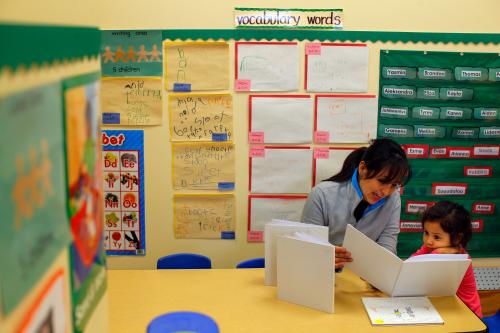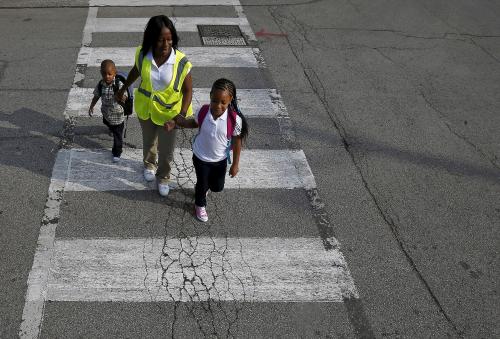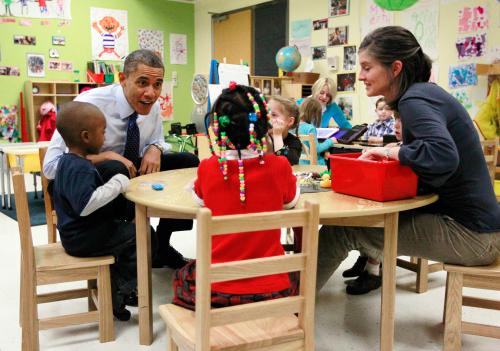Few policy ideas rival the popularity of spreading preschool about the land.
George H. W. Bush created a national child care program in 1990, granting federal support to working-class families not served by Head Start. New York City Mayor Bill de Blasio hopes to extend free pre-K to all 3- and 4-year-olds, whether raised in rich or poor families. Even the macho-leaning Trump administration talks of buoying young parents, as Ivanka Trump presses Congress to pump $25 billion into paid family leave (mainly for high-bracket taxpayers).
Yet prickly questions continue to nag advocates of a universal pre-K entitlement. First, do the benefits of pre-K extend beyond poor children, including offspring of middle-class parents? Or should government continue to focus on lifting youngsters who start school already behind? Enthusiasts like de Blasio seem lost in tortured logic: If pre-K elevates all kids, rich and poor, how will this small-scale institution narrow disparities in children’s growth?
Second, even the early boost enjoyed by poor children–repeatedly found in research over the past half-century with local and national samples, randomly assigning kids or deploying quasi-experimental methods–often fades through elementary school. If high-quality programs cannot be built on a wide scale, why not pursue more cost-effective strategies, such as paid leave, liberalizing earned income credits for families, or lifting school quality?
And interwoven with these empirical questions, parents wring their hands over what kind of preschool best nurtures their youngster. Early educators preach learning through play. But don’t I want to ready my child for the cognitive rigors of school?
Discovering middle-class benefits
My research team began to ask whether certain facets of pre-K quality might enhance or constrain effects that result from pre-K. Maybe if we isolated on “high quality” preschools, we could detect benefits of larger magnitude, even for middle-class kids. Or, perhaps it’s particular facets of the social organization found inside classrooms that drives stronger gains for young children.
We are not the first investigators to pursue this question. But we opted to innovate on the measurement side, thanks to a huge birth sample, drawn and tracked over time by the National Center for Education Statistics. This dataset–the Early Childhood Longitudinal Study-Birth Cohort–tracked child care and pre-K experiences of 6,150 children from birth through 5 years of age. We estimated pre-K effects for the average American child, along with benefits enjoyed by those from poor households. The middle class, strictly defined by the median income of this national sample of families with young children, earned just under $38,000 yearly (current dollars in 2005).
Our team found that the nation’s average 4-year-old attending a typical pre-K does show slightly accelerated cognitive growth when compared with peers who remain in their home with a parent or informal caregiver. But the magnitude of this advantage remains small, a finding that’s consistent with two prior national studies.
We could not detect any discernible boost when children attend preschools scoring higher on a conventional observational measure of classroom quality, confirming earlier work by Rachel Gordon at the University of Illinois, Chicago. Nor could we discern any boost for children attending pre-K for the entire day, when compared with youngsters enrolled for half days. One important exception is for black preschoolers, who benefit more from full-day programs.
But when isolating on preschools in which teachers spend more time on oral language, preliteracy skills, and math concepts–programs we call academically oriented–we found considerably stronger benefits on children’s cognitive growth. Estimated effect sizes moved up from about one-sixth to two-fifths of a standard deviation for children who entered close to age 4 and attended a full year.
Even middle-class children, when attending academic pre-Ks, were about two months ahead of peers who sorted into garden-variety programs. These benefits persisted into kindergarten. We found no slowing of children’s social development in these instructional rich preschools.
What kind of pre-K pays off?
Herein lies the rub, as the New York Times headline writer put it when covering these results: “Free Play or Flash Cards.” Old-line early educators emphasize how the cognitive apparatus of toddlers and preschoolers is maturing. This requires what they dub “developmentally appropriate practices.” It doesn’t work to teach physics to toddlers, so the logic goes, although they may be constantly in motion.
But in a somewhat twisted interpretation of the Swiss learning theorist Jean Piaget, learning-through-play is put forward as the exclusive way of engaging young children, even purging cognitively challenging activities or discouraging guided play that advances complex language, solving puzzles, or tackling basic mathematical dynamics. Anecdotally, a journalist friend asked his son’s pre-K teacher why no letters or words appeared on classroom walls, only to be told that it would be “developmentally inappropriate.”
Our study falls short of classroom prescriptions. But the findings do suggest that when teachers purposefully embed richer language, familiarity with children’s books, and counting or set theory into invigorating tasks, the benefits rise–even for children of the nation’s true middle class. Researchers as the University of Virginia have spent decades showing how playful activities inside pre-K classrooms can be infused with cognitively demanding tasks and plenty of emotional support.
Future research
We still do not know whether a crisper focus on language and preliteracy skills packs a sufficient punch to lift downstream school performance of children raised in middle-class households. Another intriguing question is whether pre-K benefits now emerge as America’s middle-class becomes more diverse, with upwardly mobile families of Asian or Latino heritage only recently acquiring fluency in English. More research is required to understand these pluralistic home conditions, set against efforts out in the states to improve pre-K quality.
For now, our new findings show how certain facets of quality may widen the punch packed by quality pre-K programs–lifting not only poor children but also peers raised in more secure homes and neighborhoods. Fellow scholars report similar results for local samples in Boston and Tulsa.
But then again, if we verify that pre-K is lifting a wider range of children, including those situated in America’s colorfully diverse middle class, have we arrived at the optimal policy for narrowing early gaps in children’s growth? Or will we find that pre-K acts to simply reinforce disparities put in place by differing family practices and neighborhood inequities–much like the effects of stratified public schools?






Commentary
Building better preschools—but for which kids?
July 20, 2017